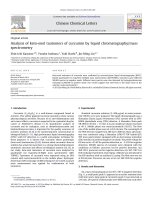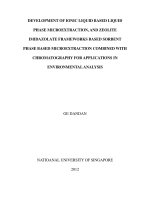Investigation and application of liquid chromatography mass spectrometry in the analysis of polar, less volatile and thermal unstable organic pollutants in environmental and biological samples 5
Bạn đang xem bản rút gọn của tài liệu. Xem và tải ngay bản đầy đủ của tài liệu tại đây (306.63 KB, 22 trang )
5. Chapter Five
Investigation of Propoxur and Its Transformation Products in Aquatic
Plants and Animals Using Microwave-assisted Extraction Followed by
LC-APCI-ITMS
5.1 INTRODUCTION
Propoxur, one of the important pesticides of the carbamate group, is widely used against
household insects. It is a potent inhibitor of cholinesterase and is moderately toxic to
humans and animals, having an LD
50
of 100 mg/kg in rats [1]. It is classified as
moderately hazardous by the World Health Organization (WHO) [2] and the acceptable
daily intake for humans has been set at 0.02 mg/kg by WHO [3]. Due to its high
solubility and instability in water, propoxur and metabolites (N-methylformamide and 2-
isopropoxyphenol) are potential contaminants of the aquatic environment and food
resources, such as fish, tortoises and alga, which play significant roles as a carrier of
propoxur and its TPs. Therefore, evaluation and estimation of the potential risk of
propoxur and its transformation products (TPs) for plants and animals in the aquatic
environment are necessary.
As already emphasized previously, LC-MS is one of the most powerful techniques for the
analysis of polar pesticide residues. In the past few years, much work has been done by
LC-MS to analyze carbamate pesticides contained in various types of matrices, such as
aquatic samples [4-6], and fruits and vegetables [7-11]. To our knowledge, however, little
effort has been made to analyze carbamates residues in biological samples with LC-API-
MS, except in one study done by Kawasaki et al wherein they used LC-APCI-MS to
120
analyze eight carbamate pesticides (isoprocarb, metocarb, fenobucarb, xylylcarb, XMC,
ethiofencarb, propoxur, and carbaryl) in blood from patients suffering from acute
poisoning [12]. In addition, liquid-liquid extraction (LLE) has been commonly used to
extract carbamates (for example, carbofuran, furathiocarb, benfuracarb, carbaryl, and
propoxur) from various kinds of biological samples [13-15]. However, LLE has many
disadvantages - namely, it requires large amounts of toxic organic solvents and is time-
consuming.
As described above, MAE has become a very attractive sample preparation
technique as it overcomes the aforementioned disadvantages. Yet, extraction from
biological samples by MAE has been limited to the determination of methylmercury [16-
19], arsenic speciation [20-22], and fatty acids [23]. Currently, there are very few MAE
methods available for the analysis of pesticide residues in biological samples, except
chlorinated pesticides, which can be detected in a freeze-dried mussel tissues using
focused MAE [24].
Based on the above considerations, in this study, LC-APCI-MS technique coupled to
MAE, was selected to monitor trace residues of propoxur and its TPs found in biological
materials in the aquatic environment. Our work is firstly concentrated on the MAE
optimization by using orthogonal array design (OAD) procedure. Secondly, the
application of optimized techniques for the extraction of target pesticides from spiked
biological materials [goldfish, tortoises (Trachemys scripta elegans) and sea lettuce (Ulva
lactuca)] is described. Finally, the stability studies of propoxur under microwave
irradiation and in tested biological extracts at their respective optimum conditions are
discussed.
121
5.2 EXPERIMENTAL
5.2.1 Reagents and Standards
Propoxur was purchased from ChemService (See chapter 2).
Both 2-isopropoxyphenol and N-methylformamide were obtained from Aldrich
(Steinheim, Germany). Stock standard solutions were prepared in methanol at
concentrations of 1000 µg/ml for each compound and stored at - 4°C. Working solutions
were prepared by diluting the stock solutions with methanol.
5.2.2 Sample Preparations
The preparation of these biological samples is described in detail in Chapter 2.
5.2.3 Sample Extraction
5.2.3.1 Optimization strategy for MAE
In our previous study, very good results (above 95% of recovery) had been obtained for
propoxur extraction from soil with 30 ml of methanol, an 80 °C extraction temperature,
and 6-min microwave heating. The differences between the distribution of propoxur and
its transformation products in biota and soils, and additionally the difference in the
122
sample preparation processes (soils were spiked at ambient conditions and air-dried,
whereas biota tissues in the present study were freeze-dried), required that there be
optimization of extraction step. For this, a two-level orthogonal array design (OAD) was
applied.
In this study, two different experiments were designed to optimize MAE conditions for
the extraction of the target. According to our mode designed earlier, the four important
variables selected for optimizing MAE are: (1) extraction solvents (factor A), (2)
extraction temperature (factor B), (3) extraction time (factor C), and (4) solvent volume
(factor D). One factor not considered was the power setting for the microwave heating.
This setting was proportional to the number of samples undergoing extraction during one
run. Furthermore, according to previous experience with MAE and intuition, one two-
variable interactions to be considered was B x C (interaction between different extraction
temperature and extraction time). Because four two-level variables and one two-variable
interaction were to be considered, a total of five degrees of freedom was required, and the
OA
8
(2
7
) matrix was, therefore, chosen so as to have sufficient degrees of freedom for
the assignment of the variables under consideration. The assignment of the main
variables (A, B, C and D), two-variable interaction, and the level setting values of the
main variables applied to aquatic animals (goldfish and tortoises) and sea lettuce are
displayed in Table 5-1.
123
Table 5-1. Assignment table of variables and the arrangement of the experiment runs
using an OA
8
(2
7
) matrix
Column No.
Level
1 2 3 4 5 6 7
Extraction
species
settings
A* B* # C* # B x C* D*
I Methanol
60
ο
C
6 min 20 ml
Goldfish
and
Tortoises
II
Acetone/Hexane
(1:1)
80
ο
C
8 min 30 ml
I Methanol
60
ο
C
6 min 20 ml
Sea
lettuce
II Dichloromethane
80
ο
C
8 min 30 ml
#: Dummy factor
*A: Extraction solvent; B: Extraction temperature; C: Extraction time; D: Volume of
extraction solvent; B x C: Interaction between extraction temperature and time
5.2.3.2 MAE procedures and the treatment of extracts
For every sample in each species extracted by MAE, 1 g of a spiked sample was
accurately weighed out and quantitatively transferred to the PIFE-lined extraction vessel.
After adding the needed volume of the extracting solvent (Table 5-1 and Table 5-2), 10-
min equilibration was allowed before extraction. During optimization of the MAE
conditions, the extraction conditions of each pre-designed experimental trial (a total of 8)
were set according to the two-level OAD procedure given in Table 5-1 and Table 5-2.
124
Table 5-2. The OA
8
(2
7
) matrix with the experimental results
* Average response of each level
Column No.
Average recovery (%)
Expt
.
No.
1 2 3 4 5 6 7 Goldfish Tortoises Sea lettuce
1
1 1 1 1 1 1 1
78.6 79.6 80.5
2
1 1 1 2 2 2 2
81.0 78.7 81.1
3
1 2 2 1 1 2 2
84.8 84.1 89.2
4
1 2 2 2 2 1 1
85.4 86.3 86.7
5
2 1 2 1 2 1 2
74.3 76.1 80.9
6
2 1 2 2 1 2 1
71.5 69.4 72.6
7
2 2 1 1 2 2 1
77.9 78.6 83.7
8
2 2 1 2 1 1 2
81.1 81.3 84.9
Goldfish
*
r
1
82.4 76.4 79.7 78.9 79.0 79.9 78.4
r
2
77.0 82.3 79.0 79.8 79.7 78.8 80.3
Tortoises
r
1
82.2 76.0 79.6 79.6 80.0 80.9 78.5
r
2
76.4 82.6 79.0 79.0 78.6 77.7 80.1
Sea lettuce
r
1
84.4 78.8 82.6 83.6 81.8 83.3 80.9
r
2
80.5 86.1 82.3 81.3 83.1 81.6 84.0
After extraction, the vessels were cooled down to room temperature before they were
opened, preventing any organic solvent fumes from being detected by the solvent
detector within the instrument, which would cause a shut-down. Sample extracts were
further separated by centrifugation at 419 rod S
-1
for 15 min. The supernatant was then
evaporated in a rotary evaporator. Finally, 1 ml of methanol was added to dissolve the
residue that was directly analyzed by LC-MS.
125
5.2.4 LC-MS Measurements
The LC-APCI-MS instrument was initially tuned with a tuning solution (a mixture of
caffeine, MRFA, and ultromark 1621) in both positive and negative ionization modes. In
order to ensure optimal tuning conditions, the propoxur standard was delivered into the
APCI source through an electronically controlled syringe pump. Typical tuning
parameters were: vaporizer temp: 450.00 °C, sheath gas flow rate: 80 arb, aux gas flow
rate: 20 arb, discharge current: 5.00 µA, capillary temp: 150.00 °C, capillary voltage:
35.00 v, tube lens offset: 5.00 v, and corona voltage: 4.50 kv.
Selective monitoring (SIM) was performed at m/z 60 ([M+H]
+
), 151([M-H]
-
)
and 210
([M+H]
+
). The dwell time for each channel was 0.1 s, with an interchannel delay of 0.02
s and a mass span of 1 mass unit. Quantitation was based on the area under the peak from
the mass chromatogram of the above molecular ions at m/z 60, 151, and 210.
For the LC separation of propoxur and its two transformation products (N-methyl
formamide and 2-isopropoxyphenol), a mixture of ultrapure water-methanol (50:50) was
used as a mobile phase at a constant flow-rate of 0.6 ml/min. A Phenomenex ODS 150 x
3.2 mm column was utilized for separation. The HPLC system was interfaced with the
ion trap through the APCI source. Mass spectra collected in full-scan mode were obtained
by scanning over a range of m/z 50 to 250. Maximum injection time was set at 150 ms.
Time scheduled mass conditions were shown as following scheme:
126
30 LC time
(min)
22156 2 0
SIM mode (m/z 151 and 210) in the negative and positive
ion detection modes, respectively
SIM mode (m/z 60)
Full-scan mass range of m/z 50 to 250
5.3 RESULTS AND DISCUSSION
5.3.1. LC-MS Analysis
The structures of propoxur and its two metabolites (2-isopropoxyphenol and N-methyl
formamide) are given in Fig. 5-1, together with their typical APCI spectra in full scan
mode (m/z 50-250) acquired from direct injections of standard solution of each
compound. MS
2
spectra were recorded by isolating the quasi-molecular ions, followed by
a 30% collision-induced dissociation (CID) energy, and are also presented in Fig. 5-1.
From Fig. 5-1(a), it can be seen in the mass spectrum that the quasi-molecular ion of
propoxur at m/z 210 is the most intense peak. The MS
2
spectrum reveals that two
fragment ions were detected. One is [M+H-42]
+
at m/z 168, probably because of the loss
of a 1-propene (C
3
H
6
) molecule, the other is the base peak at m/z 153 [M+H-57]
+
, which
probably resulted from the neutral loss of a CH
3
NCO group. MS studies of other
carbamate pesticides have reported an identical product ion [M-CONCH
3
+H]
+
[15] that is
believed to be a key characteristic of N-methylcarbamate pesticides. Fig. 5-1 (b) shows
that the most abundant ion in the MS spectrum of 2-isopropoxyphenol is [M-H]
-
at m/z
127
151. The MS
2
analysis of that ion, at m/z 151 with 30% CID energy, shows fragment ions
corresponding to cleavage of C-C and C-O bonds. A fragment ion at m/z 121 [M-H-30]
-
was detected as two CH
3
groups were lost, whereas the m/z 109 [M-H-42]
-
probably
resulted from the neutral loss of 1-propene, similar to the formation of a fragment ion of
propoxur at m/z 168. For N-methylformamide, one peak at m/z 60 [M+H]
+
was detected
in the MS spectrum, whereas no MS
2
spectrum was obtained, as m/z values of fragment
ions are too small to be recorded (Fig. 5-1 (c)). In all the cases, small peaks can be
ignored when their relative intensities are less than 20% of the corresponding base peak.
In this study, SIM of quasi-molecular ions in each tested compound at m/z 210, m/z 151
and m/z 60, were selected for quantitative analysis. Fig. 5-2 shows the individual SIM
chromatogram for all three compounds in a mixture of 0.10 ng/µl of a solvent-based
standard.
(a)
+C Full MS
2
210.00 @ 30 [50.00-250]
+
C APCI Full MS (m/z 50
-
250)
128
(b)
-C Full MS
2
151.00 @ 30 [m/z 50.00-250]
-C APCI Full MS (m/z 50-250)
+C APCI Full MS (m/z 50-250)
(c)
Fig. 5-1. APCI full MS (and MS
2
) spectra of (a) propoxur and (b) 2-isopropoxyphenol
and (c) N-methylformamide.
129
3.21
18.92
100
0
%
21.01
100
0
%
(c)
(b)
100
0
(a)
%
Relative abundance
(
%
)
8
12
16
24
20
4
Fig. 5-2. SIM chromatogram for (a) N-methylformamide, (b) propoxur and (c) 2-
isopropoxyphenol in a standard mixture (0.10 ng/µl of each analyte in
methanol).
Retention Time
(
min
)
130
5.3.2 Data Analysis Strategy for MAE Optimization
After implementing the eight experimental trials, which were pre-designed according to
the OA
8
(2
7
) matrix, the corresponding average recovery (AR) for each experimental trial
was calculated and then tabulated (Table 5-2). The average of the responses (r
1
and r
2
) for
each factor at different levels was also calculated and is shown in Table 5-2. Table 5-2
reflects the values for goldfish, tortoises, and sea lettuce.
Based on methods described in previous work [22, 23], the results of the sums of squares
for different variables and so-called interaction columns for each extraction species were
calculated (see Table 5-3, 5-4 and 5-6). For each tested species, two-variable interactions
were assigned to column 6. Furthermore, columns 3 and 5 were treated as dummies and
used for estimating the error variance in this optimization. Subsequently, the ANOVA
tables were constructed (Table 5-3 to 5-5).
Table 5-3. Variance analysis table in the OA
8
(2
7
) matrix for the optimization of MAE
from goldfish
A B C D B х C Error
Items
Extraction
solvent
Extraction
temperature
Extraction
time
Solvent
volume
SS 58.3 69.6 1.6 7.2 2.4 2.0
d.f. 1 1 1 1 1 2
MS 58.3 69.6 1.6 7.2 2.4 1.0
F-Value 58.3 69.6 1.6 7.2 2.4
Significance
a
P<0.05** P<0.05**
SS= sum of squares; d.f.= degrees of freedom;
a
The critical F value is 18.51 (**P < 0.05) and 8.53 (*P< 0.1)
131
From Table 5-3, it can be seen that only factor A (extracting solvent) and factor B
(extraction temperature) are statistically significant (p < 0.05), whereas no statistical
differences are observed for any other variables and interactions considered (p < 0.1). It is
clear from the average recovery (AR) results that the combination of A
1
and B
2
would
result in a maximum response. Since effects of duration time and volume of the solvents
(factors C and D) are minor, less solvent and time are preferred. Thus, the optimum MAE
conditions for the extraction of propoxur and its two TPs from goldfish tissue can be
summarized as follows: 20-ml of methanol, an optimum microwave heating temperature
of 80 °C, and a 6-min of microwave heating.
Table 5-4. Variance analysis table in the OA
8
(2
7
) matrix for the optimization of MAE
from tortoises
A B C D B х C Error
Items
Extraction
solvent
Extraction
temperature
Extraction
time
Solvent
volume
SS 67.3 87.1 0.7 5.1 20.5 4.6
d.f. 1 1 1 1 1 2
MS 67.3 87.1 0.7 5.1 20.5 2.3
F
a
29.3 37.9 0.3 2.2 8.9
Significance P< 0.05** P< 0.05** P< 0.1*
SS= sum of squares; d.f.= degrees of freedom;
a
The critical F value is 18.51 (**P < 0.05) and 8.53 (*P< 0.1)
Table 5-4 shows the results, which are used to optimize the extraction from tortoises.
From the table, it is clear that factor A and factor B are statistically significant (p < 0.05),
exactly as in the extraction from fish tissue. However, the small difference between the
132
extractions from goldfish and tortoises tissues is that the two-variable interaction B х C
(interaction between extraction, temperature, and time) is statistically significant (p < 0.1)
for the extraction from the latter, whereas it has a minor effect in extraction from
goldfish. Comparing the r1 and r2 for factors B and C (see Table 5-2), it is clear that the
optimum levels are B
2
and C
1
. On the other hand, because the interaction B х C is
statically significant (p < 0.1), the choice of the optimum experimental conditions for
factors B and C must depend on their interaction, which can be evaluated using a 2 х 2
table (Table 5-5). The method of construction of a 2 х 2 table is described in detail
elsewhere [22].
Table 5-5. Two-by-Two table for the analysis of the B х C interaction during the
tortoises’ extraction
Average recovery (AR)
B
1
B
2
C
1
77.9 81.4
C
2
74.1 83.8
From Table 5-5, it is obvious that for AR, the combination of B
2
and C
2
would result in
the maximum response. Therefore, the optimum MAE conditions for the extraction of
target analytes from tortoises are: 20 ml of methanol and 8 min of microwave heating at
80 °C.
Table 5-6 shows the results with regard to the optimization of extraction from sea lettuce.
Factor A, factor B, and factor D are statistically significant at p < 0.1, whereas the effects
of factor C and interaction (B х C) are less important. Minor differences are observed for
133
the following variables: Factor B is significant at p < 0.05, while both factors A and D are
statistically significant at p < 0.1. Thus, the optimization conditions selected for algal
extraction are 30 ml of methanol and 6 min microwave heating at 80 °C. Basically
according to experience, the magnetron power of the microwave heating was at 80%
outputs (960W). The solvent temperature was able to reach the pre-set microwave
temperature within 1-2 minutes of microwave heating during the extraction. An important
point to note when employing the OAD procedure is that although some parameters
(duration of extraction and volume of solvent) may not be statistically significant during
this optimization exercise, it does not mean that they are not important for the recoveries
of target pesticides during MASE. The selection of levels for each parameter may be too
close or too far apart in magnitude to be statistically significant at all. Thus, it should be
emphasized that adequate judgment and preexisting experience are necessary for properly
identifying appropriate factors and their levels; this is normally a case-by-case situation.
Table 5-6. Variance analysis table in the OA
8
(2
7
) matrix for the optimization of MAE
from sea lettuce
A B C D B х C Error
Items
Extraction
solvent
Extraction
temperature
Extraction
time
Solvent
volume
SS 30.4 106.6 10.6 19.2 5.8 3.6
d.f. 1 1 1 1 1 2
MS 30.4 106.6 10.6 19.2 5.8 1.8
F-Value 16.9 59.2 5.9 10.7 3.2
Significance
a
P<0.1* P<0.05** P<0.1*
SS= sum of squares; d.f.= degrees of freedom;
a
The critical F value is 18.51 (**P < 0.05) and 8.53 (*P< 0.1)
134
Table 5-7. The Recoveries of different analytes in spiked biological samples under
respective optimized MAE
Extraction Samples
Recoveries (%) ± RSD (%) n=6
Propoxur 2-isopropoxyphenol N-methyl-formamide
Goldfish
92.2 ± 4.4 69.6 ± 6.3 93.8 ± 3.1
Tortoises
93.1 ± 3.9 70.3 ± 5.7 95.5 ± 4.3
Sea lettuce
96.4 ± 4.0 74.8 ± 6.1 97.4 ± 2.6
The respective optimized MAE conditions employed for the extraction of the analytes
and their results are given in Table 5-7.
An interesting result observed from Table 5-7 is that under the optimized MAE
conditions, good recoveries (>90%) of propoxur and N-methylformamide (with excellent
reproducibility) were obtained in all tested samples, whereas the recovery of 2-
isopropoxyphenol was low (~70%), possibly owing to conjugation with glucuronide to
form 2-isopropoxyphenol-glucuronide, which cannot be detected at m/z 151. Similar
results reported indicate that, conjugated 2-isopropoxyphenol is the major metabolite in
rats [4] and in human urine [5, 6]. This is probably a characteristic of the metabolism of
Propoxur. Although those studies reported that more than 75% of 2-isopropoxyphenol
could be found in its conjugated form, probably as glucuronide in tested living bodies, the
2-isopropoxyphenol conjugation in this study is not as serious as those studies because
135
the 2-isopropoxyphenol was introduced by direct spiking and not by oral ingestion.
Furthermore, another interesting result was that although methanol was demonstrated to
be a very good extractant for MAE, a slightly better recovery of 2-isopropoxyphenol was
obtained in algal samples when dichloromethane was used as the extractant.
5.3.3 Stability of Propoxur under Microwave Irradiation
One of the main objectives in speciation analysis is the assurance that the targets are
stable during the whole process. The effects of the microwave irradiation during
extraction were studied by analyzing a standard propoxur solution (1 µg/ml). An aliquot
of this solution was subjected to the microwave extraction under the optimum conditions
established. The experiments were performed in two replicates and each replicate was
measured twice. The results showed that neither evaporation losses nor propoxur
decomposition were produced in a closed microwave oven. Thus, the stability of the
analytes tested during testing is clearly assured. Evidence is presented in Fig. 5-3, which
shows the typical chromatograms obtained before and after microwave extraction (80°C,
8 min extraction time, and 20 ml of methanol).
5.3.4 Stability of Propoxur and Its TPs in Tested Extracts with Time
In order to determine the stability of biota extracts prior to measurement, freeze-dried
biological samples considered in this work containing propoxur, N-methylformamide,
and 2-isopropoxyphenol, were extracted under MAE at their respective optimal
conditions. Aliquots of the extracts were analyzed after 12, 24, 48, and 72h. The results
136
of the fresh extracts were taken as references. Extracts were kept at 4°C between
analyses. Fig. 5-4 shows the change in concentration of each of the analytes in the
goldfish extracts with time. From the figure, it can be seen that neither a decrease in the
concentration of the extracts nor propoxur decomposition was observed after 72 h.
Furthermore, similar results were found in the tortoise and algal extracts (not shown),
thus permitting a delay of 3 days before the measurement of the biological samples, if
necessary.
0.005AUFS0.005AUFS
After MAE
Before MAE
0 5 10 15 20
Fig. 5-3. Chromatograms of propoxur in solution before and after MAE.
137
0
2
4
6
8
10
Fresh extrac
t
12 h
24 h
48 h
72 h
I II
II IV
Fig. 5-4. Stability of the tested analytes in the fish extracts with time. Concentrations are expressed
in dry weight. I) Propoxur; II) 2-Isopropoxyphenol; III) N-methyl-formamide; IV)
average
of species tested
5.4 CONCLUSIONS
In the previous chapters I have discussed the stability studies of carbamate pesticides in
environmental waters by using liquid chromatography-atmospheric pressure chemical
ionization-ion trap mass spectrometry, coupled to microwave-assisted extraction
technique, together with the orthogonal array design for optimization of the MAE
conditions. To apply these techniques in practical applications, in this chapter I
138
demonstrated the application of these techniques in analysis of the residues of N-
methylcarbamate and related compounds (propoxur and its metabolisms as model
compounds) in biological materials (goldfish, tortoises and sea lettuce).
By comparison the statistical significance of the MAE factors, I found the optimum MAE
conditions for the extraction of propoxur and its two TPs from biological tissue can be
summarized in the below table.
Factors
Bio-sample
Volume of solvent
(methanol, ml)
Microwave heating
temperature (°C)
Microwave heating
time (minutes)
Goldfish 20 80 6
Tortoise 20 80 8
Algal 30 80 6
Under the optimized MAE conditions, good recoveries (>90%) of propoxur and N-
methylformamide (with excellent reproducibility) were obtained in all tested samples,
whereas the recovery of 2-isopropoxyphenol was low (~70%), possibly owing to
conjugation with glucuronide to form 2-isopropoxyphenol-glucuronide as reported by
other researchers [25].
The stability of propoxur under microwave irradiation was maintained as neither
evaporation losses nor propoxur decomposition was observed during the process. The
extracts of goldfish, tortoises and sea lettuce were stable and a 3-days delay prior to
analysis was possible.
139
5.5 REFERENCES
[1] C.M. Kamanavalli, H.Z. Ninnekar, J. Microbio. Biotech. 16 (2000) 329.
[2] W.J. Hayes (Ed.), Pesticides Studied in Man, Williams and Wilkins, London, 1982,
448.
[3] F.C. Lu, Regul. Toxicol. Pharmacol. 21 (1995) 352
[4] S. Chiron, J.A. Torres, A. Fernandezalba, M.F. Alpendurada, D. Barcelo, Inter. J.
Environ. Anal. Chem. 65 (1996) 37.
[5] M. Honing, D. Barcelo, BLM. Vanbaar, UAT. Brinkman, TrAC-Trends Anal.
Chem. 14 (1995) 496.
[6] R. Jeannot, E. Sauvard, J. Food Sci. 12 (2000) 219.
[7] A. Dicorcia, C. Crescenzi, A. Lagana, J. Agric. Food Chem. 44 (1996) 1930.
[8] M. Fernandez, Y. Pico, J. Manes, J. Chromatogr. A 871 (2000) 43.
[9] A. Volmer, J. Chromatogr. A 794 (1998) 129.
[10] A. Di Corcia, C. Crescenzi, A. Lagana, J. Agric. Food Chem. 44 (1996) 1930.
[11] E. Lacassie, M.F. Dreyfuss, J.L. Daguet, M. Vignaud, P. Marquet, G. Lachâtre, J.
Chromatogr. A 830 (1999) 135.
[12] S. Kawasaki, F. Nogumo, H. Ueda, Y. Yajima, M. Sano, J. Tadano, J. Chromatogr.
620 (1993) 61.
[13] V.H. Sharma, R.K. Jadhav, G.J. Rao, A.K. Saraf, H. Chandra, Forensic Sci, Int. 42
(1990) 21.
[14] S. K. Lee, K. Ameno, S. W. In, W. K.Yang, K. S. Koo, Y. C. Yoo, T. Kubota, S.
Ameno, I. Ijiri, Forensic Sci. Intem. 101(1999) 65.
140
[15] S. K. Lee, K. Ameno, J.Y. Yang, S. W. In, K.U. Kim, Y.J. Kwon, Y.C. Yoo, T.
Kubota, S. Ameno, I. Ijiri, Intem. J. Legal Med. 112 (1999) 268.
[16] V. Lopez-Avila, R. Young, W.R. Beckert, Anal. Chem. 66 (1994) 1097.
[17] V. Lopez-Avila, R. Young, J. Benedicto, P. Ho, R. Kim, F.W. Beckert, Anal. Chem.
67 (1995) 2096.
[18] S.J. Stout, A.R. da Cunha, D.G. Allardice, Anal. Chem. 68 (1996) 653.
[19] R. Rodil, A.M. Carro, R.A. Lorenzo, M. Abuin, R. Cela, J. Chromatogr. A 963
(2002) 313.
[20] E. Ramalhosa, S.R. Segade, E. Pereira, C. Vale, A. Duarte, Analyst 126 (2001)
1583.
[21] E. Ramalhosa, S.R. Segade, E. Pereira, C. Vale, A.Duarte, J. Anal. Atom. Spec. 16
(2001) 643.
[22] C. Dietz, Y. Madrid, C. Camara, P. Quevauviller, Anal. Chem. 72 (2000) 4178.
[23] J.A. Brisbin, J.A. Caruso, Analyst 127 (2002) 921.
[24] P.M. Yehl, H. Gurleyuk, J.F. Tyson, P.C. Uden, Analyst 126 (2001) 1511.
[25] A.R. Banijamali, Y.D. Xu, V. DeMatteo, R. J. Strunk, S.J. Sumner, J. Agr. Food
Chem. 48 (2000), 4693.
141
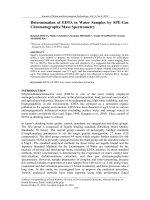
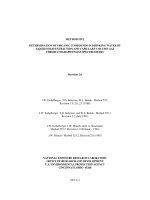
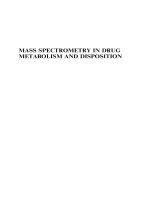
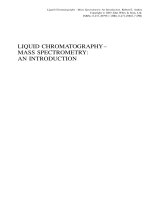
![niessen - liquid chromatography - mass spectrometry 3e [lcms] (crc, 2006)](https://media.store123doc.com/images/document/14/ne/ea/medium_eaq1401870789.jpg)
